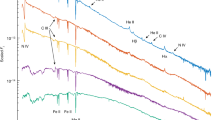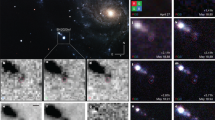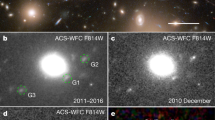Abstract
The light curves of type Ia supernovae are routinely used to constrain cosmology models. Driven by radioactive decay of 56Ni, the light curves steadily decline over time, but after 150 d post-explosion the near-infrared portion is poorly characterized. We report a year-long plateau in the near-infrared light curve at 150–500 d, followed by a second decline phase accompanied by a possible appearance of [Fe i] emission lines. This near-infrared plateau contrasts sharply with type IIP plateaux and requires a new physical mechanism. We suggest a masking of the ‘near-infrared catastrophe’—a predicted, yet unobserved, sharp light-curve decline—by scattering of ultraviolet photons to longer wavelengths. The transition off the plateau could be due to a change in the dominant ionization state of the supernova ejecta. Our results help explain the complex radiative transfer processes that take place in type Ia supernovae and enhance their use as ‘standard candles’.
This is a preview of subscription content, access via your institution
Access options
Access Nature and 54 other Nature Portfolio journals
Get Nature+, our best-value online-access subscription
$29.99 / 30 days
cancel any time
Subscribe to this journal
Receive 12 digital issues and online access to articles
$119.00 per year
only $9.92 per issue
Buy this article
- Purchase on Springer Link
- Instant access to full article PDF
Prices may be subject to local taxes which are calculated during checkout






Similar content being viewed by others
References
Truran, J. W., Arnett, W. D. & Cameron, A. G. W. Nucleosynthesis in supernova shock waves. Can. J. Phys. 45, 2315–231 (1967).
Colgate, S. A. & McKee, C. Early supernova luminosity. Astrophys. J. 157, 623–62 (1969).
Arnett, W. D. Type I supernovae. I—Analytic solutions for the early part of the light curve. Astrophys. J. 253, 785–797 (1982).
Axelrod, T. S. Late Time Optical Spectra from the Ni-56 Model for Type 1 Supernovae. PhD thesis, Univ. California, Santa Cruz (1980).
Cappellaro, E. et al. SN IA light curves and radioactive decay. Astron. Astrophys. 328, 203–210 (1997).
Leloudas, G. et al. The normal Type Ia SN 2003hv out to very late phases. Astron. Astrophys. 505, 265–279 (2009).
Fransson, C. & Jerkstrand, A. Reconciling the infrared catastrophe and observations of SN 2011fe. Astrophys. J. 814, L2 (2015).
Graur, O. et al. Late-time photometry of Type Ia supernova SN 2012cg reveals the radioactive decay of 57Co. Astrophys. J. 819, 31 (2016).
Graur, O. et al. Observations of SN 2015F suggest a correlation between the intrinsic luminosity of Type Ia supernovae and the shape of their light curves >900 days after explosion. Astrophys. J. 859, 79 (2018).
Graur, O. et al. Late-time observations of ASASSN-14lp strengthen the case for a correlation between the peak luminosity of Type Ia supernovae and the shape of their late-time light curves. Astrophys. J. 866, 10 (2018).
Graur, O. Late-time observations of the Type Ia supernova SN 2014J with the Hubble Space Telescope Wide Field Camera 3. Astrophys. J. 870, 14 (2019).
Shappee, B. J., Stanek, K. Z., Kochanek, C. S. & Garnavich, P. M. Whimper of a bang: documenting the final days of the nearby Type Ia supernova 2011fe. Astrophys. J. 841, 48 (2017).
Yang, Y. et al. Late-time flattening of Type Ia supernova light curves: constraints from SN 2014J in M82. Astrophys. J. 852, 89 (2018).
Dimitriadis, G. et al. The late-time light curve of the Type Ia supernova SN 2011fe. Mon. Not. R. Astron. Soc. 468, 3798–3812 (2017).
Kerzendorf, W. E. et al. Extremely late photometry of the nearby SN 2011fe. Mon. Not. R. Astron. Soc. 472, 2534–2542 (2017).
Li, W. et al. Observations of Type Ia supernova 2014J for nearly 900 days and constraints on its progenitor system. Astrophys. J. 882, 30 (2019).
Chevalier, R. A. The hydrodynamics of Type II supernovae. Astrophys. J. 207, 872–887 (1976).
Candia, P. et al. Optical and infrared photometry of the unusual Type Ia supernova 2000cx. Publ. Astron. Soc. Pac. 115, 277–294 (2003).
Krisciunas, K. et al. Optical and infrared photometry of the nearby Type Ia supernova 2001el. Astron. J. 125, 166–180 (2003).
Sollerman, J. et al. The late-time light curve of the Type Ia supernova 2000cx. Astron. Astrophys. 428, 555–568 (2004).
Stritzinger, M. & Sollerman, J. Late-time emission of Type Ia supernovae: optical and near-infrared observations of SN 2001el. Astron. Astrophys. 470, L1–L4 (2007).
Pastorello, A. et al. ESC and KAIT observations of the transitional Type Ia SN 2004eo. Mon. Not. R. Astron. Soc. 377, 1531–1552 (2007).
Matheson, T. et al. The infrared light curve of SN 2011fe in M101 and the distance to M101. Astrophys. J. 754, 19 (2012).
Pan, Y.-C. et al. 500 days of SN 2013dy: spectra and photometry from the ultraviolet to the infrared. Mon. Not. R. Astron. Soc. 452, 4307–4325 (2015).
Marion, G. H. et al. SN2012cg: evidence for interaction between a normal Type Ia supernova and a non-degenerate binary companion. Astrophys. J. 820, 92 (2016).
Sand, D. J. et al. Post-maximum near-infrared spectra of SN 2014J: a search for interaction signatures. Astrophys. J. 822, L16 (2016).
Burns, C. R. et al. The Carnegie Supernova Project: absolute calibration and the Hubble constant. Astrophys. J. 869, 56 (2018).
Diamond, T. R. et al. Near-infrared spectral evolution of the Type Ia supernova 2014J in the nebular phase: implications for the progenitor system. Astrophys. J. 861, 119 (2018).
Dhawan, S. et al. Nebular spectroscopy of SN 2014J: detection of stable nickel in near-infrared spectra. Astron. Astrophys. 619, A102 (2018).
Spyromilio, J. et al. Optical and near infrared observations of SN 1998bu. Astron. Astrophys. 426, 547–553 (2004).
Avelino, A. et al. Type Ia supernovae are excellent standard candles in the near-infrared. Preprint at https://arxiv.org/abs/1902.03261 (2019).
Li, W. et al. The unique Type Ia supernova 2000cx in NGC 524. Publ. Astron. Soc. Pac. 113, 1178–1204 (2001).
Maguire, K. et al. Using late-time optical and near-infrared spectra to constrain Type Ia supernova explosion properties. Mon. Not. R. Astron. Soc. 477, 3567–3582 (2018).
Graham, M. L. et al. Constraining the progenitor companion of the nearby Type Ia SN 2011fe with a nebular spectrum at +981 d. Mon. Not. R. Astron. Soc. 454, 1948–1957 (2015).
Taubenberger, S. et al. Spectroscopy of the Type Ia supernova 2011fe past 1000 d. Mon. Not. R. Astron. Soc. 448, L48–L52 (2015).
Patat, F. Reflections on reflexions—I. Light echoes in Type Ia supernovae. Mon. Not. R. Astron. Soc. 357, 1161–1177 (2005).
Patat, F., Benetti, S., Cappellaro, E. & Turatto, M. Reflections on reflexions—II. Effects of light echoes on the luminosity and spectra of Type Ia supernovae. Mon. Not. R. Astron. Soc. 369, 1949–1960 (2006).
Rest, A., Sinnott, B. & Welch, D. L. Light echoes of transients and variables in the local universe. Publ. Astron. Soc. Aust. 29, 466–481 (2012).
Cappellaro, E. et al. Detection of a light echo from SN 1998BU. Astrophys. J. 549, L215–L218 (2001).
Borkowski, K. J. et al. Dust destruction in Type Ia supernova remnants in the Large Magellanic Cloud. Astrophys. J. 642, L141–L144 (2006).
Gomez, H. L. et al. Dust in historical galactic Type Ia supernova remnants with Herschel. Mon. Not. R. Astron. Soc. 420, 3557–3573 (2012).
Nozawa, T. et al. Formation of dust in the ejecta of Type Ia supernovae. Astrophys. J. 736, 45 (2011).
Douvion, T., Lagage, P. O., Cesarsky, C. J. & Dwek, E. Dust in the Tycho, Kepler and Crab supernova remnants. Astron. Astrophys. 373, 281–291 (2001).
Williams, B. J. et al. Dust in a Type Ia supernova progenitor: Spitzer spectroscopy of Kepler’s supernova remnant. Astrophys. J. 755, 3 (2012).
Mattila, S. et al. Massive stars exploding in a He-rich circumstellar medium—III. SN 2006jc: infrared echoes from new and old dust in the progenitor CSM. Mon. Not. R. Astron. Soc. 389, 141–155 (2008).
Anupama, G. C. et al. Optical photometry and spectroscopy of the Type Ibn supernova SN 2006jc until the onset of dust formation. Mon. Not. R. Astron. Soc. 392, 894–903 (2009).
Kasen, D. Secondary maximum in the near-infrared light curves of Type Ia supernovae. Astrophys. J. 649, 939–953 (2006).
Höflich, P. Analysis of the Type IA supernova SN 1994D. Astrophys. J. 443, 89 (1995).
Pinto, P. A. & Eastman, R. G. The physics of Type IA supernova light curves. II. Opacity and diffusion. Astrophys. J. 530, 757–776 (2000).
Nugent, P., Phillips, M., Baron, E., Branch, D. & Hauschildt, P. Evidence for a spectroscopic sequence among Type 1a supernovae. Astrophys. J. 455, L147 (1995).
Hack, W. J. et al. AstroDrizzle: more than a new MultiDrizzle. In American Astronomical Society Meeting Abstracts Vol. 220 135.15 (AAS, 2012).
Dolphin, A. E. WFPC2 stellar photometry with HSTPHOT. Publ. Astron. Soc. Pac. 112, 1383–1396 (2000).
Deustua, S. E. et al. UVIS 2.0 Chip-Dependent Inverse Sensitivity Values Instrument Science Report WFC3 2016-03 (STScI, 2016).
Vernet, J. et al. X-shooter, the new wide band intermediate resolution spectrograph at the ESO Very Large Telescope. Astron. Astrophys. 536, A105 (2011).
Modigliani, A. et al. The X-shooter pipeline. Proc. SPIE 7737, 773728 (2010).
Freudling, W. et al. Automated data reduction workflows for astronomy. The ESO reflex environment. Astron. Astrophys. 559, A96 (2013).
Maguire, K., Taubenberger, S., Sullivan, M. & Mazzali, P. A. Searching for swept-up hydrogen and helium in the late-time spectra of 11 nearby Type Ia supernovae. Mon. Not. R. Astron. Soc. 457, 3254–3265 (2016).
Kausch, W. et al. Molecfit: a general tool for telluric absorption correction. II. Quantitative evaluation on ESO-VLT/X-Shooter spectra. Astron. Astrophys. 576, A78 (2015).
Smette, A. et al. Molecfit: a general tool for telluric absorption correction. I. Method and application to ESO instruments. Astron. Astrophys. 576, A77 (2015).
Brown, T. M. et al. Las Cumbres Observatory Global Telescope Network. Publ. Astron. Soc. Pac. 125, 1031 (2013).
Valenti, S. et al. The diversity of Type II supernova versus the similarity in their progenitors. Mon. Not. R. Astron. Soc. 459, 3939–3962 (2016).
Ryan, R. E. Jr, Casertano, S. & Pirzkal, N. Linear: a novel algorithm for reconstructing slitless spectroscopy from HST/WFC3. Publ. Astron. Soc. Pac. 130, 034501 (2018).
Troja, E. et al. The X-ray counterpart to the gravitational-wave event GW170817. Nature 551, 71–74 (2017).
Hillier, D. J. & Miller, D. L. The treatment of non-LTE line blanketing in spherically expanding outflows. Astrophys. J. 496, 407–427 (1998).
Hillier, D. J. & Dessart, L. Time-dependent radiative transfer calculations for supernovae. Mon. Not. R. Astron. Soc. 424, 252–271 (2012).
Tyndall, N. B., Ramsbottom, C. A., Ballance, C. P. & Hibbert, A. Photoionization of Co+ and electron-impact excitation of Co2+ using the Dirac R-matrix method. Mon. Not. R. Astron. Soc. 462, 3350–3360 (2016).
Quinet, P., Le Dourneuf, M. & Zeippen, C. J. Atomic data from the IRON Project. XIX. Radiative transition probabilities for forbidden lines in Fe II. Astron. Astrophys. Suppl. 120, 361–371 (1996).
Quinet, P. Transition probabilities for forbidden lines of Fe III. Astron. Astrophys. Suppl. 116, 573–578 (1996).
Skrutskie, M. F. et al. The Two Micron All Sky Survey (2MASS). Astron. J. 131, 1163–1183 (2006).
Mayya, Y. D., Puerari, I. & Kuhn, O. Supernova 1998bu in NGC 3368. IAU Circ. 6907, 2 (1998).
Jha, S. et al. The Type Ia supernova 1998bu in M96 and the Hubble constant. Astrophys. J. Suppl. Ser. 125, 73–97 (1999).
Hernandez, M. et al. An early-time infrared and optical study of the Type Ia supernova 1998bu in M96. Mon. Not. R. Astron. Soc. 319, 223–234 (2000).
Meikle, W. P. S. The absolute infrared magnitudes of Type Ia supernovae. Mon. Not. R. Astron. Soc. 314, 782–792 (2000).
Brown, P. J. et al. Red and reddened: ultraviolet through near-infrared observations of Type Ia supernova 2017erp. Astrophys. J. 877, 152 (2019).
Tully, R. B., Courtois, H. M. & Sorce, J. G. Cosmicflows-3. Astron. J. 152, 50 (2016).
Schlafly, E. F. & Finkbeiner, D. P. Measuring reddening with Sloan Digital Sky Survey stellar spectra and recalibrating SFD. Astrophys. J. 737, 103 (2011).
Yang, Y. et al. The young and nearby normal Type Ia supernova 2018gv: UV-optical observations and the earliest spectropolarimetry. Preprint at https://arxiv.org/abs/1903.10820v1 (2019).
Guillochon, J., Parrent, J., Kelley, L. Z. & Margutti, R. An open catalog for supernova data. Astrophys. J. 835, 64 (2017).
Acknowledgements
We thank G. Brammer, D. Eisenstein, W. Kerzendorf, S. Sim and L. Strolger for helpful discussions and comments, S. Dhawan for sharing his spectra of SN 2014J and A. Calamida, W. Eck, M. Gennaro and W. Januszewski for supporting the HST programs used here. O.G. is supported by an NSF Astronomy and Astrophysics Fellowship under award AST-1602595. K.M. acknowledges support from H2020 through an ERC Starting Grant (758638). M.N. is supported by a Royal Astronomical Society Research Fellowship. R.F. acknowledges support from NASA ATP award 80NSSC18K1013. This work is based on data obtained with the NASA/ESA HST, all of which was obtained from the Mikulski Archive for Space Telescopes (MAST). Support for MAST for non-HST data is provided by the NASA Office of Space Science via grant NNX09AF08G and by other grants and contracts. This work is based on data taken at the European Organization for Astronomical Research in the Southern Hemisphere, Chile, under programme IDs 0100.D-0242(A) and 0101.D-0443(A). The research has made use of NASA’s Astrophysics Data System and the NASA/IPAC Extragalactic Database (NED), which is operated by the Jet Propulsion Laboratory, California Institute of Technology, under contract with NASA. The NIST databases were funded, in part, by NIST’s Standard Reference Data Program (SRDP) and by NIST’s Systems Integration for Manufacturing Applications (SIMA) Program. Finally, this work has made use of the Open Supernova Catalog78.
Author information
Authors and Affiliations
Contributions
O.G. planned the observations for HST programs GO–15686 and 15693, reduced the HST imaging data, performed the analysis and wrote the manuscript. K.M. obtained the ground-based spectra of SN 2017erp. M.N. reduced the Gemini spectra of SN 2014J. R.R. reduced the grism observation of SN 2017erp obtained through HST program GO–15686. A.A. measured Δm100(H) values for the correlation study. A.G.R. planned the HST observations for programs GO–12880, 15145 and 15640. I.R.S., R.F. and L.S. assisted with the theoretical analysis of the observations.
Corresponding author
Ethics declarations
Competing interests
The authors declare no competing interests.
Additional information
Peer review information Nature Astronomy thanks Yi Yang and the other, anonymous, reviewer(s) for their contribution to the peer review of this work.
Publisher’s note Springer Nature remains neutral with regard to jurisdictional claims in published maps and institutional affiliations.
Supplementary information
Supplementary Information
Captions for Supplementary Tables 1 and 2 and Supplementary Data 1–5.
Supplementary Table 1
Machine-readable table presenting HST photometry of SNe 2012ht, 2013dy, 2017erp, 2018gv and 2019np.
Supplementary Table 2
Machine-readable table presenting synthetic photometry of SN 2014J.
Supplementary Data 1
Source data for Fig. 2.
Supplementary Data 2
Source data for Fig. 3a.
Supplementary Data 3
Source data for Fig. 3b.
Supplementary Data 4
Source data for Fig. 4.
Supplementary Data 5
Source data for Fig. 5: machine-readable table presenting the HST grism spectrum of SN 2017erp.
Rights and permissions
About this article
Cite this article
Graur, O., Maguire, K., Ryan, R. et al. A year-long plateau in the late-time near-infrared light curves of type Ia supernovae. Nat Astron 4, 188–195 (2020). https://doi.org/10.1038/s41550-019-0901-1
Received:
Accepted:
Published:
Issue Date:
DOI: https://doi.org/10.1038/s41550-019-0901-1



